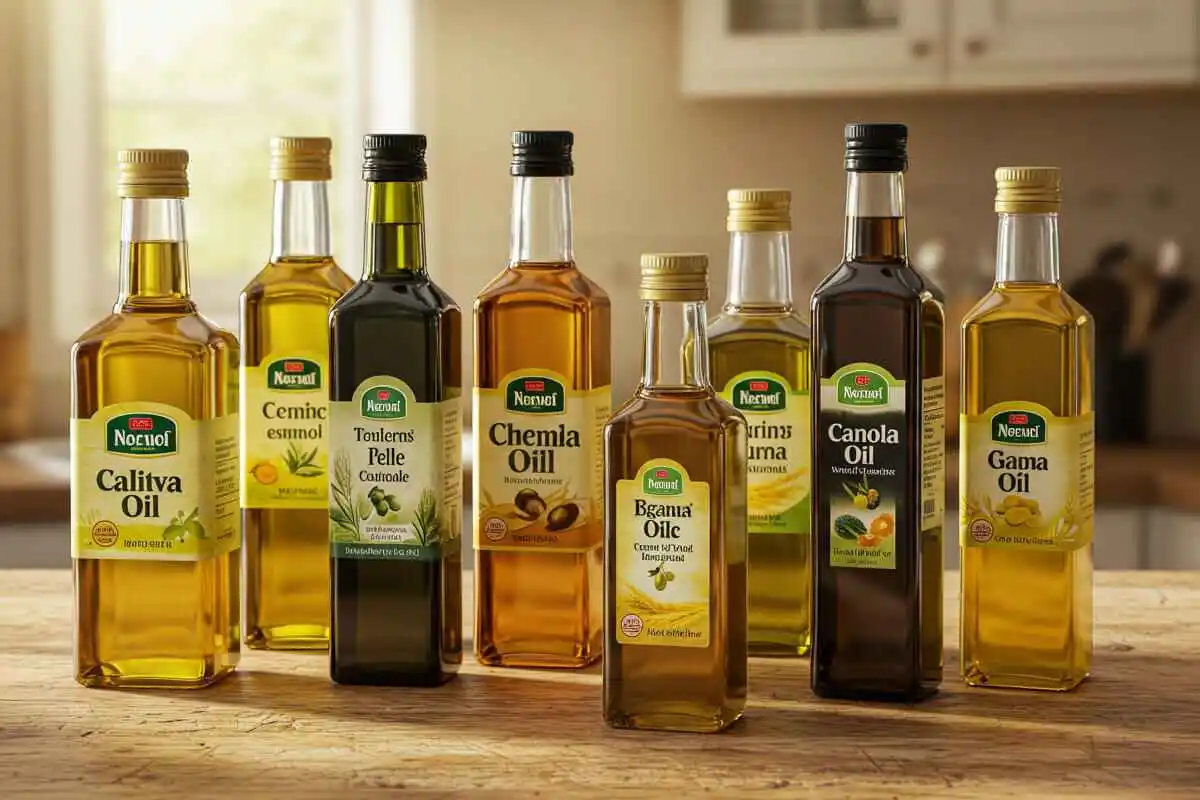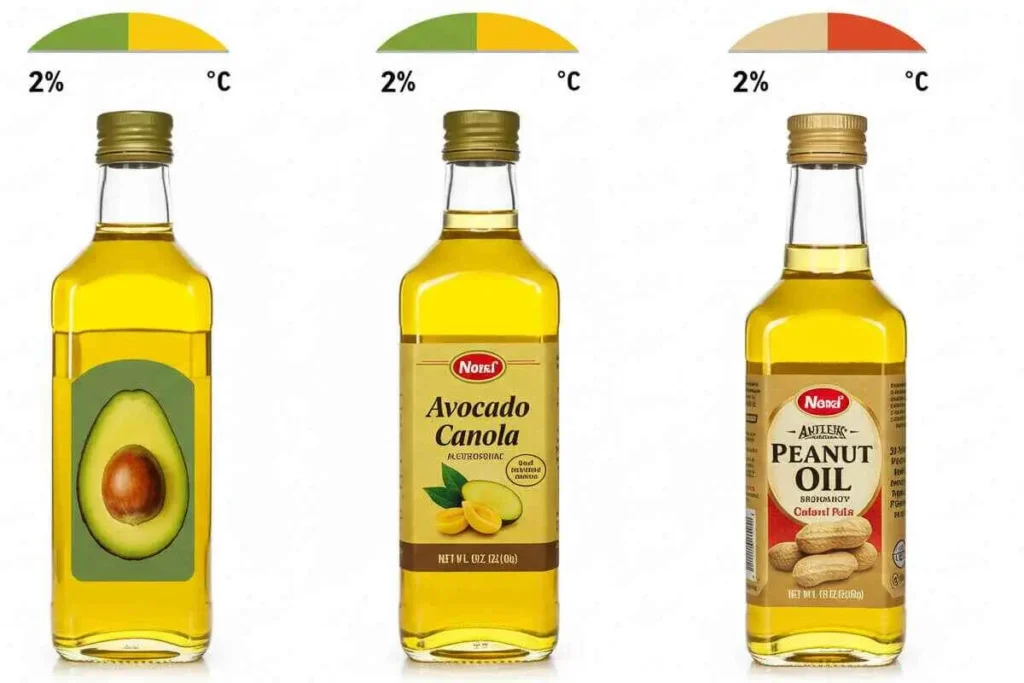Introduction
Choosing the right oil for frying can significantly impact the flavor, nutrition, and safety of your food. With so many options available, it can be confusing to figure out what oil is best for frying. Some oils are better suited for high-heat cooking, while others can break down and release harmful compounds.
In this guide, we’ll explore the top choices for frying oils, their health benefits, and the science behind selecting the perfect oil. Whether you’re deep frying, pan-frying, or stir-frying, knowing which oil to use can elevate your cooking and protect your health.
Understanding Frying Oils
What Makes an Oil Suitable for Frying?
Not all oils are created equal. The best frying oils are those that have a high smoke point—the temperature at which the oil starts to smoke and break down. When this happens, not only does the taste change, but it can also release toxic compounds.
Additionally, oils used for frying should have a neutral flavor unless you’re specifically aiming for a distinct taste. They should also be stable under heat, meaning they don’t oxidize easily and degrade into unhealthy by-products.
Types of Fats: Saturated vs. Unsaturated
Frying oils typically fall into three categories:
- Saturated fats: Stable at high temperatures but often linked to health concerns if consumed excessively. Examples include coconut oil and palm oil.
- Monounsaturated fats: Heat-stable and considered heart-healthy. Avocado oil and olive oil fall into this group.
- Polyunsaturated fats: Less stable under high heat. While they’re healthy in raw forms like salad dressings, they can oxidize when used for frying. Think flaxseed oil or walnut oil.
Role of Smoke Point in Frying
Oils with high smoke points are ideal for frying. Here’s a quick reference:
| Oil Type | Smoke Point (°F) |
|---|---|
| Avocado Oil | 520°F |
| Safflower Oil | 510°F |
| Peanut Oil | 450°F |
| Canola Oil | 400°F |
| Olive Oil | 375–405°F |
As you can see, avocado and safflower oils are top performers for high-heat applications.
 Top Oils for Frying
Top Oils for Frying
Canola Oil
Canola oil is a favorite due to its high smoke point (400°F) and neutral flavor. It’s low in saturated fat and high in omega-3 fatty acids, making it a heart-friendly choice. It’s widely available and budget-friendly—perfect for everyday frying.
Peanut Oil
Peanut oil is popular for deep frying thanks to its robust smoke point (450°F) and nutty flavor. It’s commonly used in Asian and Southern cuisine. While tasty, it may not be suitable for those with peanut allergies.
Sunflower Oil
This oil boasts a high smoke point (440°F) and light taste. Rich in vitamin E and low in saturated fats, it’s a good option for pan-frying and sautéing. Make sure to choose high-oleic sunflower oil for better stability.
Avocado Oil
Avocado oil is the reigning champion in terms of smoke point (up to 520°F). It’s rich in monounsaturated fats and has a mild, buttery flavor. Though pricier, it’s ideal for high-heat cooking and packed with health benefits.
Grapeseed Oil
This oil is valued for its neutral taste and moderate smoke point (420°F). It’s a good middle-ground oil, though it’s higher in polyunsaturated fats, which means it’s best not to overheat or reuse it.
Coconut Oil
Coconut oil has a lower smoke point (350°F) but is saturated-fat-rich, making it more stable at medium heat. Its strong, tropical flavor may not suit all dishes, but it’s great for certain types of baking and frying.
Olive Oil (Light and Refined)
While extra virgin olive oil isn’t ideal for frying due to a lower smoke point (~375°F), refined olive oil and light olive oil can handle up to 465°F. They also carry powerful antioxidants and heart-protective properties.
Rice Bran Oil
With a smoke point of around 450°F, rice bran oil is a versatile and economical choice. It’s rich in antioxidants and vitamin E, with a light taste that won’t overpower your food.
Safflower Oil
Safflower oil can handle high heat (up to 510°F) and has a neutral flavor. It’s great for crisp frying and often used in commercial kitchens due to its stability.
Vegetable Oil Blends
Many store-brand “vegetable oils” are blends of canola, soybean, and corn oils. These are cheap and decent for frying, but the exact smoke point can vary. Always check labels for content and heat ratings.
Factors to Consider When Choosing Frying Oil
Smoke Point and Its Significance
The smoke point is crucial because it marks the temperature at which oil begins to smoke and degrade. Using oil past its smoke point can not only ruin the taste but also produce harmful free radicals and acrolein—a compound that causes the burnt smell.
Opt for oils with a smoke point at least 50°F above your intended cooking temperature. For deep frying, this typically means using oils with a smoke point of 400°F or higher.
Flavor Profile and Its Impact on Food
Some oils like peanut or coconut oil have strong, distinctive flavors that can enhance certain recipes but clash with others. In contrast, oils such as canola, vegetable, or grapeseed are more neutral, making them ideal for frying foods where you don’t want the oil to overpower the taste.
Choose flavored oils when you’re aiming for a specific culinary touch; otherwise, stick to neutrals.
Nutritional Value and Health Implications
Not all oils contribute equally to health. Oils high in monounsaturated fats like avocado and olive oil support heart health, while those rich in omega-6 polyunsaturated fats, like corn and soybean oils, may cause inflammation if overused.
Avoid partially hydrogenated oils at all costs—they contain trans fats linked to heart disease and other chronic conditions.
Cost and Availability
Let’s be practical—while avocado oil is top-tier in performance and health, it’s also expensive. Canola and vegetable oil blends strike a good balance between cost and utility. Availability is another consideration, especially if you cook frequently or in bulk.
Reusability and Shelf Life
Oils like peanut and canola can be reused a few times if filtered and stored properly. However, delicate oils such as grapeseed or sunflower degrade faster.
Always inspect oil after use—if it smells rancid or has darkened significantly, it’s time to discard it.
Health Implications of Frying Oils
Oils High in Monounsaturated Fats
These fats are heat-stable and heart-healthy, making oils like olive, avocado, and high-oleic sunflower prime choices. They can reduce LDL (bad cholesterol) and maintain HDL (good cholesterol), contributing to cardiovascular wellness.
Oils High in Polyunsaturated Fats
Although rich in essential fatty acids like omega-6 and omega-3, polyunsaturated oils like corn, soybean, and grapeseed are more prone to oxidation under heat. If you must use them, avoid high-heat methods and never reuse them.
Saturated Fats and Heart Health
Saturated fats like those found in coconut oil are more stable but have long been debated in the health world. In moderation, they’re safe, especially when unrefined and used at appropriate temperatures.
Trans Fats and Their Risks
Even small amounts of trans fats—often present in partially hydrogenated oils—are harmful. They raise bad cholesterol, lower good cholesterol, and increase your risk of stroke, diabetes, and heart disease. These should be avoided altogether.
 Best Oils for Specific Frying Methods
Best Oils for Specific Frying Methods
Deep Frying
Ideal oils: Peanut, canola, rice bran, safflower
These oils offer high smoke points, neutral taste, and are cost-effective, making them perfect for deep-frying foods like french fries, chicken, and doughnuts.
Shallow Frying
Ideal oils: Sunflower, olive (refined), avocado
Because the temperature is lower than deep frying, you can use oils with slightly lower smoke points but still need good stability.
Stir-Frying
Ideal oils: Peanut, sesame, grapeseed
The quick cooking process benefits from oils that can withstand rapid heat. Sesame oil adds a wonderful flavor for Asian dishes.
Pan-Frying
Ideal oils: Olive oil, coconut oil, canola
Use oils that balance flavor and performance. Coconut oil works well for sweet or tropical dishes, while olive oil is great for eggs and vegetables.
Common Mistakes When Using Frying Oils
Overheating Oils
One of the most frequent errors is letting the oil get too hot. This can cause the oil to smoke, break down, and develop harmful compounds. Always preheat oils gradually and use a thermometer to monitor the temperature—aim for 350°F to 375°F for most frying.
Reusing Oils Excessively
While reusing oil is economical, overdoing it leads to the buildup of oxidized fats and free radicals. A good rule of thumb: reuse oil no more than 2–3 times, and only if it’s filtered and stored properly between uses.
Mixing Different Types of Oils
Blending oils with varying smoke points can be unpredictable. For example, mixing olive oil with vegetable oil may lower the overall smoke point, increasing the risk of degradation and flavor inconsistency.
Improper Storage Practices
Storing oil in clear containers or leaving it exposed to air and heat causes it to go rancid quickly. Instead, keep oils in a cool, dark place in tightly sealed bottles to extend their shelf life.
Tips for Maintaining Oil Quality
Proper Storage Techniques
Store oils in dark glass bottles or metal containers away from light and heat. This preserves their antioxidants and prevents rancidity. Don’t store oils near your stove or in transparent containers exposed to sunlight.
Filtering and Cleaning Used Oil
After frying, let the oil cool and then strain it through a cheesecloth or coffee filter to remove food particles. Store the filtered oil in a clean, dry container. Label it with the date and food type used to avoid cross-contamination or reusing beyond safe limits.
Signs of Oil Degradation
Oil that smells like crayons, fish, or has a dark color or sticky texture is no longer safe to use. It may also foam excessively or smoke at lower temperatures than usual. These are signs it’s time to toss it.
Environmental and Ethical Considerations
Sustainability of Oil Production
Certain oils like palm oil are associated with deforestation and habitat loss. Opt for RSPO-certified palm oil or avoid it entirely in favor of more sustainable alternatives like sunflower or rice bran oil.
Impact of Palm Oil Cultivation
Palm oil is high-yielding but causes significant ecological damage. Demand for it contributes to the destruction of tropical rainforests, endangering species like orangutans. Choosing sustainably sourced oils can help reduce your carbon footprint.
Choosing Eco-Friendly Options
Look for oils that are non-GMO, organically grown, and harvested using ethical labor practices. Brands that offer recyclable packaging and transparent sourcing also contribute positively to environmental health.
Frequently Asked Questions (FAQs)
What is the best oil to use for frying?
The best oil for frying depends on the method and dish, but avocado oil ranks high due to its ultra-high smoke point (520°F) and nutritional benefits. For affordability and versatility, canola and peanut oils are also top choices thanks to their neutral flavor, high heat resistance, and wide availability.
What oil is not good for frying?
Avoid oils with low smoke points and those prone to oxidation, such as flaxseed oil, walnut oil, and extra virgin olive oil. These oils can break down at lower temperatures, producing unpleasant tastes and potentially harmful compounds.
What is the healthiest oil for cooking and frying?
Olive oil (light or refined) and avocado oil are considered the healthiest frying options. They’re rich in monounsaturated fats, support heart health, and maintain their integrity at high temperatures. High-oleic sunflower oil is another good alternative due to its heat stability and clean flavor.
Is it better to fry with canola or vegetable oil?
Canola oil is generally a better choice for frying. It has a higher smoke point (~400°F) and a more favorable fatty acid profile with less saturated fat than most vegetable oil blends. Plus, it has a neutral taste that doesn’t interfere with the flavor of your food.
Conclusion
Selecting the right frying oil isn’t just about flavor—it’s about health, performance, and even environmental impact. Oils like avocado, canola, and peanut offer the best combination of heat stability and nutritional value, while others like extra virgin olive oil or flaxseed are best reserved for drizzling or dressings.
By understanding smoke points, fat composition, and cooking methods, you can make smarter, safer, and more delicious choices in the kitchen. So next time you’re heating up the skillet, you’ll know exactly what oil is best for frying.
More Delicious Recipes
- What Type of Oil is Used at Benihana?
Cabbage and Egg Soup: A Nutritious, Easy, and Delicious Recipe
Mini Tacos Magic: 17 Delicious Ideas & Easy Recipes for Every Occasion


 Top Oils for Frying
Top Oils for Frying Best Oils for Specific Frying Methods
Best Oils for Specific Frying Methods